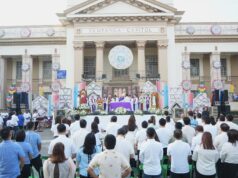CLARK FREEPORT – Central Luzon posted the highest volume of visitor arrivals in history, translating to some US$200 million in gross revenues for tourist expenditures made on accommodation, food and shopping in 2008, the Department of Tourism said.
“This means that Central Luzon posted some 530,802 visitors from January to December of 2008 as compared to only 427,364 during the same period in 2007,” said DOT-region III director Ronaldo Tiotuico in a press statement.
He said that a tourist spends around US$99 per day in an average four-night stay in a hotel in the region.
Based on informal surveys, Tiotuico said “most travelers chose to stay within Central Luzon because of value for money especially the low fares offered by international budget airlines like Cebu Pacific, Air Asia, and Tiger Airways. “Hotels and tourist inns around Clark offer cheaper rates but provide quality service.”
Overseas Filipino workers in Qatar and Dubai interviewed by Punto through the phone said that they prefer to go to Singapore first (connecting flight) and then land at the Diosdado Macapagal International Airport.
“Mas masarap yung mamasyal muna sa Central Luzon bago umuwi. Sa Manila kase grabe ang traffic, mahal ang bilihin tapos antagal pa bago ka makauwi,” they said.
The book-and-buy scheme offered to foreign tourists gave them ample reasons to travel for a cheaper cost with the same quality of service and amenities, Tiotuico said.
“While the world is experiencing the hardest-hitting financial crisis in so many decades, our region is bursting with a surprising comeback of tourists,” he added.
The much improved road network from Manila to the North Luzon area has contributed much to the significant growth of tourism in the region, he said.
“Seamless travel between the North Luzon Expressway and the Subic-Clark-Tarlac Expressway enroute to Tarlac or Subic gave value for money in times of economic slowdown,” he added.
Revenues from tourist visits amounting to P10 billion also gave vast economic headstart for tourist-catering establishments like hotels, resorts and restaurants. More hotels were built during the year that also generated thousands of jobs.
TOURIST ARRIVALS
Of the total volume of arrivals, most tourists came from the United States, around 36,326 visited the region. Japanese tourists ranked no. 2 with some 11,891 arrivals overtaking the South Koreans with 8,778 arrivals last year.
“Central Luzon will be then next region to watch for,” Tiotuico said.
“This means that Central Luzon posted some 530,802 visitors from January to December of 2008 as compared to only 427,364 during the same period in 2007,” said DOT-region III director Ronaldo Tiotuico in a press statement.
He said that a tourist spends around US$99 per day in an average four-night stay in a hotel in the region.
Based on informal surveys, Tiotuico said “most travelers chose to stay within Central Luzon because of value for money especially the low fares offered by international budget airlines like Cebu Pacific, Air Asia, and Tiger Airways. “Hotels and tourist inns around Clark offer cheaper rates but provide quality service.”
Overseas Filipino workers in Qatar and Dubai interviewed by Punto through the phone said that they prefer to go to Singapore first (connecting flight) and then land at the Diosdado Macapagal International Airport.
“Mas masarap yung mamasyal muna sa Central Luzon bago umuwi. Sa Manila kase grabe ang traffic, mahal ang bilihin tapos antagal pa bago ka makauwi,” they said.
The book-and-buy scheme offered to foreign tourists gave them ample reasons to travel for a cheaper cost with the same quality of service and amenities, Tiotuico said.
“While the world is experiencing the hardest-hitting financial crisis in so many decades, our region is bursting with a surprising comeback of tourists,” he added.
The much improved road network from Manila to the North Luzon area has contributed much to the significant growth of tourism in the region, he said.
“Seamless travel between the North Luzon Expressway and the Subic-Clark-Tarlac Expressway enroute to Tarlac or Subic gave value for money in times of economic slowdown,” he added.
Revenues from tourist visits amounting to P10 billion also gave vast economic headstart for tourist-catering establishments like hotels, resorts and restaurants. More hotels were built during the year that also generated thousands of jobs.
TOURIST ARRIVALS
Of the total volume of arrivals, most tourists came from the United States, around 36,326 visited the region. Japanese tourists ranked no. 2 with some 11,891 arrivals overtaking the South Koreans with 8,778 arrivals last year.
“Central Luzon will be then next region to watch for,” Tiotuico said.




